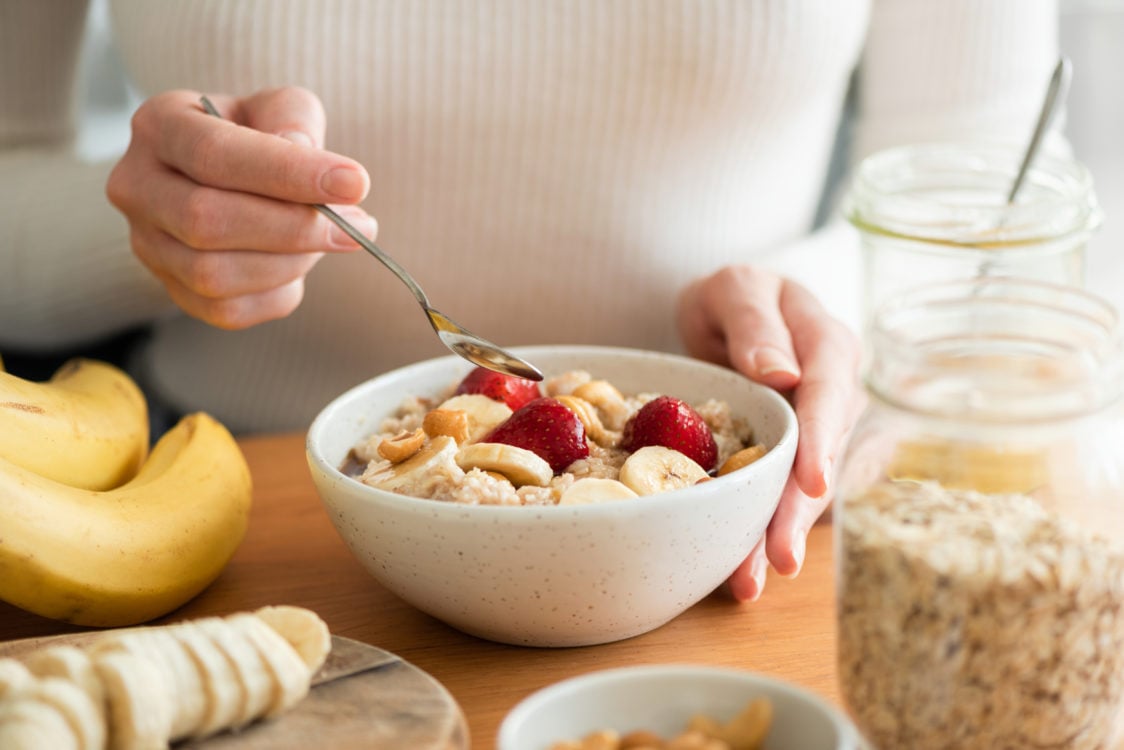Table of Contents
Weight loss and lifestyle changes are not always a cakewalk. This path is full of temptation and it’s easy to lose track. Perhaps you have already tried and failed before. This process needs a lot of determination and a well-thought-out plan. Such small things as getting enough fruits and vegetables, quality sleep or drinking enough liquids can help. So, how to ensure a smoother course of your diet and leave your worries behind? Today’s article will tell you exactly that.
Quick results don’t mean long-term success
When one starts something, they probably want to see results right away, and the same applies when losing weight. But let’s be real. No one wants to do the long-term hard work and change their habits. Everyone’s eyes light up at the thought of a possibility to get their dream figure in just a few weeks. This is also why people are so easily manipulated by the promises of various detoxes and other miraculous procedures. But these miracles usually happen only on paper.
Such quick results often require excessive restrictions and extreme changes. It’s quite common that in the pursuit of losing weight people try to eliminate several food groups, reduce portions by half or build their diet only on vegetables. Yes, with such drastic changes, you will undoubtedly lose weight. The body will have no other choice because of the significant caloric deficit. But how long can you keep this going?
You probably won’t even know how it happened, but the diet will become complicated by fatigue, headaches, lack of energy, irritability, irresistible cravings for sweets or even overeating. As a result you might stop trying to lose weight as quickly as you started.
On the other hand, if you avoid going to extremes, losing weight might take longer, but the process will definitely be more pleasant. This could bring you the weight you dream about without the weeks of unnecessary suffering, and as a bonus, you might be able to maintain it long-term.
The success of a weight loss diet doesn’t depend on its speed, but on long-term gradual changes that will become a natural part of your lifestyle.

Weight-loss-focused diet should be nutritious
Excessive restrictions also carry the risk of reduced intake of important nutrients. This can happen especially when you thoughtlessly eliminate whole food groups (cereals, dairy products, etc.). Even when losing weight, you need enough macronutrients (proteins, carbohydrates, fats), minerals, vitamins and other bioactive compounds. You can get all these only with a balanced healthy diet which contains all food groups, not just a salad.
So, if you are determined to start losing weight in the right way, you can use our calculator to calculate your recommended energy intake for weight loss and get inspired by tips on how to make your diet more enjoyable.
Before you get started, you might want to read our article 10 Things You Need to Know Before You Start Losing Weight.

10 tips to make your weight loss diet easier
1. Have a plan and prepare your meals in advance
They say that preparation is the key to success. In the language of nutrition, this practically means that if you have your meals planned and prepared in advance, you won’t end up at McDonald’s with a cup of McFlurry when you start craving something good.
How to plan your meals in advance?
- Write down what you will cook for the next few days. According to this plan, make a shopping list that you will stick to when shopping. And don’t go to the supermarket hungry, it’s not a good idea.
- Cook for a few days ahead. Reserve, for example, two days a week and devote those days to cooking. As a bonus, you will have to cook for example only on Sundays and Wednesdays, instead of every day of the week.
- Have some healthy snacks on hand. It can be a simple rye bread with ham and vegetables, kefir milk with some fruit or, for example, fermented overnight oats.
- As a last resort, have some simple foods, which you can reach for in case of need. It can be a healthier version of cookies made with whole grain flour and lower sugar content, some protein bars, a handful of nuts or seeds, various whole grain crackers, nut bars, etc.
- Always have some plain yogurt, sour drinks, skyr or other similar products in the fridge. Something you can just take out and eat without any preparation.
- Start meal prepping. Pack the pre-cooked food in a lunch box and take it with you. If you prepare food for the next day, hunger won’t catch you by surprise.
- Good main meal substitutions can be, for example, packed frozen food or high-quality ready to eat meals.
If you need some inspiration for how a meal prep day could look like, check out our article Sample Meal Prep Plan for 2000 Kcal.

2. Adapt your surroundings to the set goals
Does it also happen to you that your determination to follow good eating habits crumbles when foods you would rather avoid peek out from every cupboard at home? The universal truth is that you can’t eat what you don’t have. By not storing foods you can’t resist at home, it will be easier for you to limit how much of them you consume.
Everyone’s weakness is something else. For some, it’s chocolate, desserts and other sweets, while others can’t resist salted nuts, chips, crisps and other salty treats. Find out which foods are your weak point and reduce their intake by not having them at home.
Proper storage of food or suitable dishes can also make your efforts easier. You can read more in the article 10 Tips on How to Organize Your Kitchen for Successful Weight Loss.

3. Make sure you are consistent
Many people still think that in order to lose weight, they have to eat the smallest possible number of daily meals. The more meals you can skip, the better. One side thinks that skipping lunch is the answer, while the other side is convinced that it is necessary to skip dinner.
The result of these experiments is often great hunger and catching up on what you’ve missed before. A typical situation looks like this. Let’s take the example of Lucy, who is trying to lose weight and reads on the Internet that she should skip the biggest meal of the day, which is lunch, or eat only vegetables. After all, it will save a large amount of calories.
Lucy follows this advice and eats only a small breakfast, has a vegetable salad for lunch and in the meantime reaches for an apple. She is happy with herself, as she’s eating less than usual.
However, when she comes home from work in the evening, hunger begins to catch up with her. Ultimately, she ends up having a double portion of her dinner in one evening and then indulges in chocolate and some salted nuts, because she is constantly hungry and has cravings. In the end, she will end up receiving much more energy than if she ate a full and complete lunch.
So how many meals a day should you eat?
The answer to this question is actually very individual. It is possible that Lucy would be able to follow a weight loss diet with just three daily meals, but five or six meals could suit her just as well. However, no matter what frequency she chooses, the meals must always contain a sufficient amount of energy and nutrients. If she impulsively skips meals, sooner or later her body will probably tell her that something is missing. However, a regularly recurring amount of meals with a comparable total energy value can help ensure that she is full and doesn’t get hungry in the evening. [6,8]
You might be interested in these products:
4. Increase the consumption of foods that fill you up
When you are trying to lose weight, you should include foods that have the ability to satiate. They will thus help to prevent hunger even with an energy deficit. Foods with a fibre and protein content are therefore essential in the diet.
Dietary fibre
Fibre is an indigestible component of plant food, which, in addition to filling you up, has many other health benefits. It is, for example, essential for good digestion and it also slows down the absorption of sugar from the intestine into the blood, which, for example, helps limit sweet cravings. [2]
The richest sources of fiber are legumes and whole grain foods. They are accompanied by vegetables, fruits, nuts and seeds. You should receive roughly 25-30 g of fibre per day. [3,9]
The amount of 25 g of fibre can be obtained, for example, in the form of:
- 50 g oats (5 g fibre)
- 150 g apple (3 g of fibre)
- 30 g almonds (3 g fibre)
- 70 g buckwheat (7 g fibre)
- 70 g rye bread (4 g fibre)
- 150 g tomatoes (3 g fibre)
In order for fibre to successfully fulfil its role in the diet, make sure that it is found in every daily meal. If you have, for example, rye bread and vegetables for breakfast, you will feel fuller than after eating a white bread baguette without any vegetables.
Your fibre intake can be increased by dietary supplements, such as:
- Psyllium
- Apple fibre
- Glucomannan
- complex blend of few types of fibre
You can find more detailed information about fibre, its functions and sources in the article Dietary Fiber: Why Is It Important and What Are Its Sources?

Protein
Protein is an irreplaceable part of the human body, as it is the basic building block of muscles, hormones, enzymes, immune cells, and other cells. From the point of view of weight loss, it has the greatest satiating capacity of all macronutrients, meaning that it can help bring constant hunger and never-ending sweet cravings under control.
Protein can be found in both animal and plant foods.
- Animal sources of protein include meat, meat products, fish, eggs and dairy products.
- The plant foods richest in protein are legumes.
- In addition to the original form of legumes (lentils, beans, chickpeas, etc.), we should mention the products made from them, such as legume pasta or foods used as an alternative to meat (tofu, tempeh, etc.).
- Other meat alternatives also worth mentioning are robi, seitan, soy cubes, etc.
- Some pseudocereals, such as quinoa or amaranth, are also a good source of protein.
- You can also make your daily protein intake more interesting with various protein bars.
- Whey or plant-based protein powders can also help you. If you need help choosing the right protein supplement, our article How to Choose the Best Protein Powder for Weight Loss might help.
The recommended protein intake for an adult is between 0.8-2 g/kg of body weight. The intake value varies based on age, health condition, amount of muscle mass or amount and type of physical activity. A person with a weight of 70 kg and a sedentary lifestyle may need just 56 g of protein per day (0.8 g/kg of weight), although an intake of 1 g/kg of weight (70 g of protein) may be more beneficial. However, an active athlete with the same weight may need 2 g/kg of body weight, i.e. 140 g of protein. [5,6, 10]

5. Drink enough liquids
It’s not always true that hunger is just thirst in disguise. Liquids are often the key to fill your stomach and prevent hunger. According to the recommendations of the WHO (World Health Organization), an average adult woman with a sedentary lifestyle, living in average climatic conditions, should drink 2200 ml of liquids per day, while an average man should drink approximately 2900 ml. [4]
Another recommendation says that we should drink 30-45 ml of liquids per kilogram of body weight per day. Individual needs depend on climatic conditions, age, health, amount and intensity of physical activity, and many more. According to this recommendation, a man weighing 80 kg should drink 2400-3600 ml of liquids per day. [4]
However, this doesn’t mean that you have to drink the entire recommended amount. You can get up to 20% of this amount from food. A man with a need for 2,500 ml of liquids only needs to drink 2,000 ml in the form of drinks. [2]
The article How Insufficient Water Intake Affects Your Health will tell you why you shouldn’t forget about replenishing fluids.
What liquids to choose?
Of course, some liquids are different from others. The baseline should be pure water, possibly combined with mineral water and unsweetened tea. Sweetened or alcoholic drinks are a rich source of energy and can easily ruin your weight loss efforts.
You can read more about how the calories in drinks can disrupt your daily energy intake in the article Where Are Liquid Calories Hiding and How Do These Empty Calories Prevent You From Losing Weight?

6. Try new recipes
A healthy diet doesn’t have to be boring or tedious. On the contrary, it can often surprise with its colour and varied range of flavours.
You can discover new flavours and combinations by using, for example:
- Cereals that have not yet had a place in your diet (barley, millet, oats, etc.) and their sub-products (bulgur, porridge, oats, granola, etc.)
- Pseudocereals (amaranth, quinoa, buckwheat)
- Different types of legumes or legume pasta
- nuts and seeds
- Vegetables and fruits of all kinds
- new spices
Check out our recipes to get some inspiration:
- Prepare unusual oatmeal with gingerbread spice or cocoa and coffee.
- Replace the oatmeal with another ingredient and try quinoa porridge or milky rice.
- Hide the vegetables in a cake and try baking some pumpkin cupcakes or beetroot brownies.
- A spread doesn’t have to be only egg or tuna. Try making one from tofu or legumes.
- You don’t have to eat nuts only in yogurt. They also taste great in savoury dishes, for example as a sauce for pasta or as part of pizza dough.

7. Don’t strive for a perfect diet
Have you ever tried to lose weight and failed because you couldn’t deny yourself all the foods you initially banned? Or did you manage to do it, but it only lasted for a while? It might make you feel better that most goal-oriented diets based on perfection usually end in failure. It’s quite common that after some time it’s easy to slip into an “all or nothing” approach. For example, you manage to have a flawless diet for a certain period of time, but as soon as you treat yourself to a piece of chocolate, you continue to eat because “You already messed it up”. In the end, you take in a much larger amount of calories, and in addition, you feel physically and mentally bad. This is certainly not a sustainable and healthy approach to eating.
On the other hand, if you treat yourself to a piece of chocolate every day, you will be more satisfied and probably avoid overeating. Nobody is perfect and we, as humans, simply need that chocolate or piece of cake to live. It’s absolutely okay if this food appears in your diet from time to time. You can use the 80-20 rule as a handy guide. This means that 80% of your energy intake should be made up of nutritionally valuable foods, while the remaining 20% can be filled with chocolate, pizza or other favourite treats.

8. Get enough sleep
Many people underestimate sleep even though it is the cornerstone of success. Lack of sleep causes changes in hormone levels that prompt hunger and satiety.
- The level of ghrelin (hunger hormone) increases.
- On the other hand, the level of leptin (satiety hormone) is reduced.
The result is less satisfaction from eating, greater hunger and cravings. When on a diet, however, you need the exact opposite in order to manage being in a caloric deficit. Insufficient sleep thus affects your appetite, which is one of the reasons why it is associated with an increased risk of weight gain and obesity. [1,7]
The need for sleep is individual, but ideally you should sleep 7-9 hours a day. [7]
If you are further interested in the topic of sleep, read the article Sleep: the Most Effective Energy Booster and Fat Burner.

9. Don’t step on the bathrooom scale every day
It is common for a person trying to lose weight to start their day by stepping on the scale. Yet it is one of those activities that can really demotivate you. Weight fluctuations are natural and do not necessarily mean that you have gained body fat. So if it happens that on Tuesday morning you weigh 1 kg more than on Monday, don’t worry. It is very likely caused by, for example, a fuller digestive tract or more water in your muscles.
If weight fluctuations don’t bother you, feel free to continue with daily weighing. However, if you’re among the majority of mortals and higher digits on the scale give you nightmares, reduce the number of times you step on the scale to, say, once a week or even once every two weeks. Even this frequency is enough for you to be able to assess in the long term whether your weight is moving in the right direction.
Also, don’t forget that if you lose weight by changing your diet and exercising, body fat is not the only thing changing in your body. The amount of muscle mass changes as well. Therefore, if the amount of fat is decreasing and the amount of muscle is increasing, the number on the scale may not match your expectations. That’s why it’s good to combine weighing with measuring your body circumferences (waist, hips, etc.) and regularly take pictures of yourself in your underwear. A body composition analysers (most often done with an InBody device) will tell you in detail how much fat and muscle you have in your body.
You can learn what can be hidden behind the number on the scale in the article Why the Scale Shows You a Higher Number? It Might Not Be Fat.
10. Find a weight loss buddy
In general, any difficult task becomes easier when you are not alone. Losing weight is no exception. Find out if there happens to be someone in your family or friends circle who has similar goals as you. By supporting each other, keeping an eye on each other and sharing different tips and tricks with each other, you can make a reduction diet a lot more enjoyable experience.
When changing eating habits, the attitude of people around you can be a big issue. Whether it is your partner, family, friends or colleagues at work, you ideally need their support in order to succeed. Therefore, if they discourage you from losing weight, try to explain to them what this process means to you and why you need their support. Who knows, maybe some of them will even join you or at least stop forcing you into eating cakes and desserts.

What should you remember?
Quick results and little effort necessary are attractive even in the case of weight loss. However, it is mostly true that all shortcuts will eventually lead to failure. That’s why it’s better to put up with a long-term reduction diet. You will get rewarded with a more pleasant journey without excessive restrictions and long-lasting success in the form of maintaining a lower body weight. In order for you to lose weight successfully, you just need to focus on a regular diet, getting enough fibre and protein, getting enough sleep and meal planning. Even small things like trying new recipes or getting a friend involved will make the process more enjoyable. It doesn’t matter if weight loss takes a long time and miracles don’t happen. You know what they say: “Slow and steady wins the race”.
If you found this article interesting and useful, spread it by sharing it with your friends and family and help them achieve their goals.
[1] DASHTI, H.S. et al. Short Sleep Duration and Dietary Intake: Epidemiologic Evidence, Mechanisms, and Health Implications.– https://pubmed.ncbi.nlm.nih.gov/26567190/
[2] DUYFF, R.L. Complete Food & Nutrition Guide. New York: Academy of Nutrition and Dietetics, 2017. ISBN 978-0-544-52058-5.
[3] EFSA PANEL ON DIETETIC PRODUCTS, NUTRITION, AND ALLERGIES (NDA) Scientific Opinion on Dietary Reference Values for carbohydrates and dietary fibre. – https://onlinelibrary.wiley.com/doi/abs/10.2903/j.efsa.2010.1462
[4] EFSA PANEL ON DIETETIC PRODUCTS, NUTRITION, AND ALLERGIES (NDA) Scientific Opinion on Dietary Reference Values for water. – https://onlinelibrary.wiley.com/doi/abs/10.2903/j.efsa.2010.1459
[5] JÄGER, R. et al. International Society of Sports Nutrition Position Stand: protein and exercise. – https://www.tandfonline.com/doi/full/10.1186/s12970-017-0177-8
[6] KERKSICK, C.M. et al. International society of sports nutrition position stand: nutrient timing. – https://www.ncbi.nlm.nih.gov/pmc/articles/PMC5596471/
[7] PAPATRIANTAFYLLOU, E. et al. Sleep Deprivation: Effects on Weight Loss and Weight Loss Maintenance.– https://www.ncbi.nlm.nih.gov/pmc/articles/PMC9031614/
[8] SCHOENFELD, B.J. et al. Effects of meal frequency on weight loss and body composition: a meta-analysis. – https://pubmed.ncbi.nlm.nih.gov/26024494/
[9] Dietary Guidelines for Americans, 2020-2025. – https://www.dietaryguidelines.gov/sites/default/files/2020-12/Dietary_Guidelines_for_Americans_2020-2025.pdf
[10] Optimal Protein Intake Guide - Examine. – https://examine.com/guides/protein-intake/

